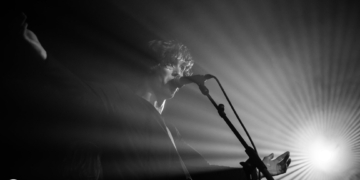With the release of Vanishing Spires, Sacred Noose have upped the ante in terms of blackened death/doom/noise and created a furiously bleak and intense record that will serve as a milestone in Irish metal.
Congratulations on the release of Vanishing Spires. Although just released, where do you think it stands in the pantheon of works that each individual member has to their name?
Adam Miles: Vanishing Spires stands to us as a collective peak in our musical works. This has pushed us to go even further with distribution and visual concepts than we’ve ever done before. I feel that we as a band have produced something intricate, yet very caustic and dissonant.
I’ve approached guitar playing in numerous different ways throughout this release alongside further developing as a noise artist within the band, so I’m quite happy with my progress across this release from a personal standpoint.
Vanishing Spires to me is a very well fleshed out display which combines what I’ve liked about the extreme metal and noise scenes for almost two decades.
Mike Largey: For me personally, I feel that Vanishing Spires just stands out as something where it was no holds barred, if there was an idea we can try it and that experimentation i think really paid off. It really pushed me as a bassist, in the past i didn’t imagine myself ever playing something so complex. I believe this the heaviest release I’ve worked on to date.
The cover is highly evocative. For some reason, I envision it set during the famine. Was this a basic concept the band had or is it solely Richard Carson’s concept?
AM: This started off from a visual concept I had revolving around the mortal desire to ascend to something greater, finding that ultimately that hope is ill-founded and then by that point, all that ultimately remains are glimpses of a world that is ultimately destroying (burning) itself. Solace in the Sacred Noose world is a myth.
I didn’t want to tie the work to a historic period or event, however given the timeless architecture of spires there’s a lot of different chronological interpretations. The core ideological concept of Vanishing Spires metaphorically holds true across the course of human history, so there’s a lot of applicability.
I wanted to emphasise the grimy, ruinous nature that comes with both mass destruction and the attempted escape from it, which Richard has taken and ran with pristinely.
What do you think you have achieved on this LP that maybe wasn’t possible on Renounce the Flesh?
AM: For Vanishing Spires, we’ve had more time to focus on our work and figure out what works for us / what doesn’t based on not just pre-production but seeing how these tracks translate into a live environment. This release also sees Steve Martin, our former guitarist takes more reins in terms of playing and contributions, which have also pushed the album forward.
The format of the release has also allowed us to expand into a range of different areas where we’ve grown our sound and what we can do whilst sticking to the same general vibe that Sacred Noose aims to portray. I feel like Renounce The Flesh was a version of us finding our feet, while Vanishing Spires has taken several decisive steps forward. Mike and I are always throwing ideas at each other however, so I don’t think we’ll converge (or aim to converge) on a repeatable sound as long as Sacred Noose exists.
Vanishing Spires has also benefited from significant additions from Mike and Steve throughout the process, which is a luxury the band didn’t really have as much of when recording Renounce The Flesh due to timescales and onboarding.
Over time, I’m building confidence with harsher noise sections and those to me are one thing that remains particularly abhorrent with Vanishing Spires. In short, it’s a significant expansion on our work.
ML: When we were making Renounce The Flesh, we had really just all came into a room together and immediately started into getting the songs down, but by this point i think we have really learned how each other works in a band, so it’s just much more of a melting pot of ideas. It was more of an opportunity to really bounce ideas back and forth. We had more of time to tweak the songs, add more layers and dynamics. As Adam and I often find ourselves playing totally separate things having that extra time to really iron out each section was something I welcomed greatly. Though I love Renounce The Flesh I think that Vanishing Spires was us just taking it to the next level in all aspects.
If both of you had to pick one song to represent the album, what would it be?
AM: I’m going to go with Black Tempests Of Promise for this one, to me it’s a brilliant embodiment of the ominous, abrasive and shifting nature we aim for across our music. It’s a good balance between being absolutely jarring and somewhat coherent with a distinctive lack of resolve. To me, it’s got a very strong visual identity from the music and lyrics combined.
All of this should not discount that every track has own well developed identity across the album, twisting across numerous genres, tempos, time signatures and techniques whilst maintaining an overall dismal soundscape.
ML: I think I’m gonna have to pick True Emancipation, I just love that song so much. It hits so ridiculously hard from the first second. And it has probably my favourite riff on the album. I cannot help but get into that song anytime we jam it out. But to be clear, I couldn’t be happier with every song on this album.
To these ears, the sound of the record is denser, thicker and more layered than Renounce the Flesh. How did this come about?
AM: Going into mixing this release, I made a conscious decision to focus on further (measured) clarity across all instruments. What I seemingly got instead was more room for the ugliness of the band to shine through, which has been a rather unpleasant (and appreciated) turn of events. Compared to Renounce The Flesh, we’ve continued to put more bass nuances in alongside more prominent counterpoint and lead guitar work. We’ve also put in more active and subtle noise sections embedded within the tracks, depending on the purpose of the particular section. Each instrument has their respective turn in taking the musical forefront in this release in different ways. There are more dual vocals, more vocal stylings, more use of stereo techniques, basically more of everything we’ve historically included along with some new elements to act as contrast pieces. Each track has its own unique, horrible touch with structures, notation and styles purposely and sometimes radically shifting even within sections to add further depth.
ML: There is definitely an element that when we were writing the songs, we actively tried to create more layers and textures to the sound. An example of this would be the intro to the track Sacred Noose, where there are 3 different things happening simultaneously. The mix of the eerie picked melody over the top, the really slogging guitar riff, and then swells on bass that have this angelic sort of sound. It just mixed so well. We approached a lot of the album in this way, both because we think it sounds great but also because it keeps it interesting for us and fun to play. But I would also want to give Adam his credit and say that he did a great job recording/mixing this album and also creating all the noise sections throughout.
Vanishing Spires is getting a limited cassette release. For my money, cassettes are the perfect format for such music as it has a crunch and dissonance that you don’t get with vinyl or CD’s. Having said that, will the album see a wider release on these formats at some point?
AM: We’ve enjoyed releasing on cassettes as an accessible and ergonomic medium for our music to be enjoyed in a physical format. We have LPs currently in production for Vanishing Spires which will be released later this year.
What’s the story with the line-up changes?
AM: Vanishing Spires was a difficult release to finalise, unfortunately. Eddie started experiencing back issues after the Siege of Limerick, and the process of finding a replacement drummer proved to be stressful at times for us as a band, with Steve leaving after the Nausea Renounced tour. It’s all on amicable terms and we still support each other with our respective projects. I believe we’ve managed as best as we could have with the challenges we’ve faced, and Vanishing Spires is a testimony to that resilience.
From the various gigs that you have played, do any in particular stand out?
AM: The tour with Sathamel was an absolute high for us. Part of our live experience feeds off audience energy and to observe people joining in with the lyrics and getting fully into what we’re playing is an unparalleled feeling. We don’t write for an audience, so that makes the feeling even more special and authentic. I’ve personally grown to prefer touring to one-off shows as I enjoy the routine and immersion of delivering continual live shows, subject to all of the technical pieces going right! We’re fortunate enough to have a highly supportive fan base across Ireland as a whole, and we’re really looking forward to showcasing our new material.
ML: I have to say the same, the Sathamel tour shows were something that I really enjoyed, as Adam has said the reaction, we got was just great and the sets felt great each time, seeing people really getting into those songs was awesome, I was honestly kind of caught off guard by the reaction of the crowd. I didn’t think anyone was that excited to see us haha. But also, Siege of Limerick was amazing, it was actually my first time there and I didn’t realise the scale of it. It was a fantastic show.
Although the Irish metal scene has always produced thought provoking works that sit alongside the greats, it doesn’t seem to be a scene that comes to mind first among outsiders. Have you found this to be the case and, if so, why?
AM: Ireland can sometimes fall out of US and European touring circuits geographically due to logistics and costs, which puts emerging bands wishing for exposure at a disadvantage where reliance on internet communities, labels and fan dedication acts as a breakthrough point. We have a smaller concentration per head of extreme acts compared to particularly our Scandinavian counterparts, and there isn’t as focused a scene here on extreme/outsider music compared to the UK which we’re looking to change as much as we feasibly can.
Thankfully, we have a range of labels and promoters across Ireland who continue to break down this barrier amidst an increasingly challenging economy which hopefully will continue and embolden over time. Ireland may be small, but its people have a lot to offer. As for our future touring plans, we hope to spread as much discomfort as people will allow us.
ML: Well, I just think that the world is a big place, and we are only a small country, so it is probably pretty easy for people around the world to overlook Ireland. Though that being said any bands I have gigged with in the past that have travelled here have loved it and have always wanted to come back. We have great bands here and a great scene, it’s up to everyone else to come and discover it for themselves.








